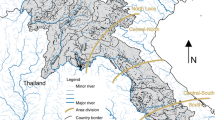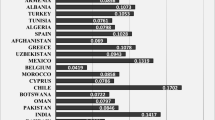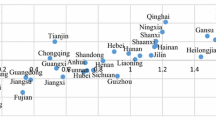Abstract
Water poverty is difficult to evaluate because it is multidimensional. It is determined not only by the availability of water sources but also whether communities have adequate access to clean, uncontaminated water. It is also dependent on the resource needs of those using the water. Under the premise that water scarcity is multidimensional, we use a Water Poverty Index approach using Principal Component Analysis to develop an index at the household level in 10 villages in one large farming community to examine each household’s subjective view of well being as a result of water poverty. This paper reviews how water resources endowments and depletion because of indiscriminate disposal of untreated industrial wastewater, household sewage and climate change are posing serious threats to water poverty at the household level in developing agrarian economies like Pakistan. We report from our results that both the perceived level of pollution and the proximity to clean and polluted water sources matter significantly for subjective well-being in rural households of Pakistan. The villages closer to polluted water sources are unhappier while the villages, which have better access to fresh water, have relatively higher subjective well-being. A strong implementation of environmental protection measures and regional strategies are suggested to alleviate water poverty and increase subjective well-being in local communities.

Similar content being viewed by others
References
Azizullah, A., Khattak, M. N. K., Richter, P., & Häder, D.-P. (2011). Water pollution in pakistan and its impact on public health—A review. Environment International, 37(2), 479–497.
Chatfield, C., & Collins, A. J. (1980). Principal component analysis. In Introduction to multivariate analysis (pp. 57–81). Springer.
Cho, D. I., Ogwang, T., & Opio, C. (2010). Simplifying the water poverty index. Social Indicators Research, 97(2), 257–267.
Cosgrove, W. J., & Loucks, D. P. (2015). Water management: Current and future challenges and research directions. Water Resources Research, 51(6), 4823–4839.
Dunteman, G.H. (1989). Principal components analysis (Number 69). Sage.
Garriga, R. G., & Foguet, A. P. (2010). Improved method to calculate a water poverty index at local scale. Journal of Environmental Engineering, 136(11), 1287–1298.
Heidecke, C. (2006). Development and evaluation of a regional water poverty index for Benin (Vol. 145). Intl Food Policy Res Inst.
Ifabiyi, I., & Ogunbode, T. (2014). The use of composite water poverty index in assessing water scarcity in the rural areas of Oyo State, Nigeria. AFRREV STECH: An International Journal of Science and Technology, 3(2), 51–65.
Jemmali, H. (2017). Mapping water poverty in Africa using the improved multidimensional index of water poverty. International Journal of Water Resources Development, 33(4), 649–666.
Jemmali, H., & Matoussi, M. S. (2013). A multidimensional analysis of water poverty at local scale: Application of improved water poverty index for Tunisia. Water Policy, 15(1), 98–115.
Jemmali, H., & Sullivan, C. A. (2014). Multidimensional analysis of water poverty in mena region: An empirical comparison with physical indicators. Social Indicators Research, 115(1), 253–277.
Jollands, N., Lermit, J., & Patterson, M. (2004). Aggregate eco-efficiency indices for New Zealand—A principal components analysis. Journal of Environmental Management, 73(4), 293–305.
Jolliffe, I. (2002). Principal component analysis. New Jersey: Wiley Online Library.
Kaiser, H. F. (1960). The application of electronic computers to factor analysis. Educational and Psychological Measurement, 20(1), 141–151.
Komnenic, V., Ahlers, R., & Van Der Zaag, P. (2009). Assessing the usefulness of the water poverty index by applying it to a special case: Can one be water poor with high levels of access? Physics and Chemistry of the Earth, Parts A/B/C, 34(4), 219–224.
Lawrence, P. R., Meigh, J., Sullivan, C., et al. (2002). The water poverty index: An international comparison. Staffordshire, UK: Department of Economics, Keele University Keele.
Manandhar, S., Pandey, V. P., & Kazama, F. (2012). Application of water poverty index (wpi) in nepalese context: A case study of kali gandaki river basin (kgrb). Water Resources Management, 26(1), 89–107.
Matshe, I., Moya-Maposa, S., & Zikhali, P. (2013). Water poverty and rural development: Evidence from South Africa. African Journal of Agricultural and Resource Economics, 8(2), 136–156.
Molle, F., & Mollinga, P. (2003). Water poverty indicators: Conceptual problems and policy issues. Water Policy, 5(5–6), 529–544.
Pan, A., Bosch, D., & Ma, H. (2017) Assessing water poverty in china using holistic and dynamic principal component analysis. Social Indicators Research, 30(2), 537–561.
Pérez-Foguet, A., & Garriga, R. G. (2011). Analyzing water poverty in basins. Water Resources Management, 25(14), 3595–3612.
Rehman, A., Bhatti, H. N., et al. (2009). Textile effluents affected seed germination and early growth of some winter vegetable crops: A case study. Water, Air, and Soil Pollution, 198(1–4), 155.
Sullivan, C. (2001). The potential for calculating a meaningful water poverty index. Water International, 26(4), 471–480.
Sullivan, C. (2002). Calculating a water poverty index. World Development, 30(7), 1195–1210.
Sullivan, C., & Meigh, J. (2005). Targeting attention on local vulnerabilities using an integrated index approach: The example of the climate vulnerability index. Water Science and Technology, 51(5), 69–78.
Sullivan, C., Meigh, J., & Lawrence, P. (2006). Application of the water poverty index at different scales: A cautionary tale: In memory of jeremy meigh who gave his life’s work to the improvement of peoples lives. Water International, 31(3), 412–426.
Sullivan, C. A., Meigh, J. R., Giacomello, A. M. (2003). The water poverty index: Development and application at the community scale. In Natural resources forum (Vol. 27, pp. 189–199). Wiley Online Library.
Van Ty, T., Sunada, K., Ichikawa, Y., & Oishi, S. (2010). Evaluation of the state of water resources using modified water poverty index: A case study in the Srepok river basin, Vietnam–Cambodia. International Journal of River Basin Management, 8(3–4), 305–317.
Vinke, K., Martin, M. A., Adams, S., Baarsch, F., Bondeau, A., Coumou, D., Donner, R. V., Menon, A., Perrette, M., Rehfeld, K. et al. (2016). Climatic risks and impacts in South Asia: Extremes of water scarcity and excess. Regional Environmental Change. doi:10.1007/s10113-015-0924-9.
Yu, C.-C., Quinn, J. T., Dufournaud, C. M., Harrington, J. J., Rogers, P. P., & Lohani, B. N. (1998). Effective dimensionality of environmental indicators: A principal component analysis with bootstrap confidence intervals. Journal of Environmental Management, 53(1), 101–119.
Author information
Authors and Affiliations
Corresponding author
Appendix
Rights and permissions
About this article
Cite this article
Nadeem, A.M., Cheo, R. & Shaoan, H. Multidimensional Analysis of Water Poverty and Subjective Well-Being: A Case Study on Local Household Variation in Faisalabad, Pakistan. Soc Indic Res 138, 207–224 (2018). https://doi.org/10.1007/s11205-017-1652-y
Accepted:
Published:
Issue Date:
DOI: https://doi.org/10.1007/s11205-017-1652-y




